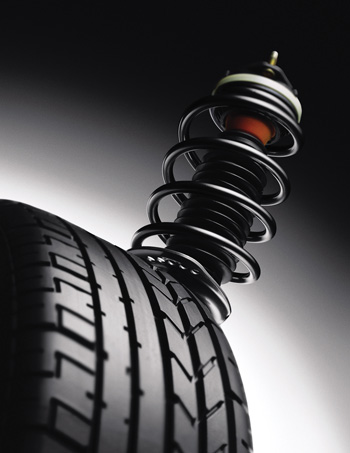Shock absorbers (and struts) provide ride control for a vehicle’s suspension. Hydraulic shocks have been used since the earliest days of the automobile to reduce suspension jounce and rebound. Without such control, wheels can bounce and lose traction, tire wear can suffer and the vehicle’s occupants can be subjected to a rough and bouncy ride. Dampening suspension motions also improves handling and stability by reducing body roll and unwanted motions. Consequently, the condition of the shocks (and struts) is important not only for good ride control but also for safe driving, steering and braking.
 Shock absorbers can last a long time, but they don’t last forever. According to extensive research and durability testing performed by four of the major shock manufacturers that are members of the Automotive Maintenance and Repair Association (AMRA), most standard shocks and struts degrade measurably by 50,000 miles. The loss of ride control has a detrimental effect on handling, stability, ride comfort and tire wear. Yet, many motorists are unaware of what’s happening because the loss of control occurs gradually over time.
Shock absorbers can last a long time, but they don’t last forever. According to extensive research and durability testing performed by four of the major shock manufacturers that are members of the Automotive Maintenance and Repair Association (AMRA), most standard shocks and struts degrade measurably by 50,000 miles. The loss of ride control has a detrimental effect on handling, stability, ride comfort and tire wear. Yet, many motorists are unaware of what’s happening because the loss of control occurs gradually over time.
One shock manufacturer told us that 86 percent of passenger cars and light trucks have NEVER had their shocks or struts replaced! That’s a lot of potential sales that are not being made.
Recognizing the fact that shocks don’t last forever and that there is solid research data to back it up, the Motorist Assurance Program’s Uniform Inspection & Communication Standards say replacing standard (non-electronic) shocks and struts at 50,000 miles can be suggested to restore proper ride control performance. Consumers need to be informed about the important role shocks and struts play in their vehicle’s suspension, and why worn shocks and struts should be replaced.
In a conventional twin-tube double-acting shock absorber, the up and down pumping action of the piston inside the shock displaces hydraulic fluid to dampen suspension motions. This stoking action occurs hundreds of times for every mile traveled, even on relatively smooth roads. Over time, it takes a toll on the piston seal and the control valves on the piston and in the bottom of the shock. Internal wear reduces resistance and the shock’s ability to do its job.
In gas pressurized shocks (both twin-tube and monotube), loss of gas pressure can also occur over time. The gas charge reduces fluid foaming, which in turn reduces shock fade. Shaft seal wear is the culprit here, allowing gas and fluid to leak out.
The shearing action that the fluid inside the shock experiences also results in a gradual loss of viscosity over time. Less viscosity means less resistance and reduced ride control performance.
Symptoms of worn shocks include suspension bottoming after hitting a bump, excessive nose dive when braking, excessive body lean or sway when cornering, a bouncy or undulating ride, wheel shudder or shimmy after hitting a bump, and cupped tire wear.












